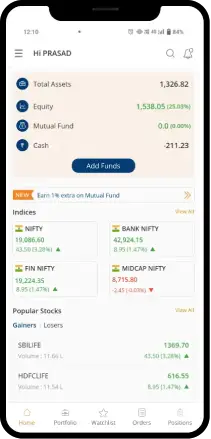Frequently Asked Questions on Mutual Funds
The basics of mutual funds in India are very easy to understand. You pay a mutual fund company a certain amount of money, either in the form of regular payments (known as the systematic investment plan or SIP) or one lumpsum amount. The mutual fund company then creates a pool (of your investments and those of others) and uses it to buy certain stocks and bonds. The mutual fund company then pays you dividends based on the performance of the stocks and bonds.
The process of how to invest in mutual funds online is Simple. Just log onto the Mirae Asset website. With our state-of-the-art onboarding facility and our 2-step investment process, you can sign-up and start investing in as little as 5 minutes**. We offer several fund profiles and payment options as well. This allows you to tailor your investment as per your needs.
To invest in SIP, you need a mutual fund account, which you can open in under 5 minutes** on the Mirae Asset website. Complete the two-step onboarding process and visit the mutual funds section on the website. You will find SIP and lumpsum investment methods. Choose the former, along with your preferred mutual funds, SIP amount and frequency and set standing instructions for us to debit the SIP amount from your linked bank account every month.
There are there different ways of how to invest in mutual funds.
- You can invest through a brokerage firm offering mutual fund accounts
- You can invest through banks offering mutual fund accounts
- You can also buy mutual funds directly from the asset management company's website.
Here are some tips to help you select the best mutual funds.
- Consider your preferred investment horizon, i.e., the duration you would like to stay invested in a mutual fund scheme. It helps to stay invested for the medium or long term to get higher returns on investment.
- Choose mutual fund schemes based on your investment objectives or goals. For instance, if you are looking for growth, you can opt for equity funds. Whereas, if you are looking for regular income, debt funds would be better suited.
- Evaluate your risk profile before investing. If you are risk-averse, then debt funds are ideal. If you are comfortable taking risks to earn higher returns, equity funds are for you. You can also invest in Hybrid funds to balance your risk-to-returns ratio.
- Choose SIP if you prefer to invest in instalments without having to time the market. If you have a corpus of funds ready to invest, you can go for lumpsum payments.
- Evaluate the track record of the fund manager and the mutual fund itself. Consider factors like past performance, decisions taken during volatile market cycles, etc.
- Look for a mutual fund with minimal expenses so that you do not end up losing your profits in fund manager's commissions, expense ratios, etc.
Here are five tips that can help you choose the best equity mutual funds.
- Choose a mutual fund based on your risk appetite. Equity Mutual funds can generate significantly higher returns. However, they involve high risks, so ensure you consider your risk appetite before investing.
- Go for mutual funds that are in line with your investment horizon. If you are in it for the long run, equity mutual funds are a better option. They may be slightly volatile, but the risk is ironed out if you stay invested for extended periods, say five years or more.
- Choose funds based on your financial goals. Define your financial goals over the short and long term and choose securities accordingly.
- Remember to choose equity mutual fund schemes after carefully comparing the fees and commissions involved. It's always advisable to opt for a mutual fund with lower charges. This ensures that more of your money is invested, and you get more bang for your buck.
- Look at the past performance of the various equity mutual fund schemes before settling on one. It is always favourable to opt for a fund that's been performing well historically.
NAV is short for Net Asset Value. It is calculated by dividing the net value of the assets held under a mutual fund by the total number of outstanding units. The NAV of a mutual fund is calculated at the end of every day. This is because the market value of the assets under the mutual funds will change daily, and so will the fund's NAV. As such, NAV helps investors keep track of the fund's performance on a day-to-day basis.
ELSS is short for Equity Linked Saving Scheme. These mutual funds invest up 80% of assets in equities, while the remaining funds may be invested in balanced or debt funds. ELSS are widely known as tax-saving mutual funds as they qualify for tax deductions of up to INR 150,000 under Section 80C of the Income Tax Act, 1961.
The process of how to invest in ELSS is simple. Simply log in to your Mirae Asset Trading Account and choose from a wide range of ELSS securities under the Mutual Funds section. Check the past performance of ELSS funds, choose your preferred investment method (lumpsum or SIP) and make your investment. Remember that ELSS comes with a 3-year lock-in period, so if you opt for SIP, each SIP instalment must be locked away for three years to avail of the tax benefit.
Index Funds are mutual funds that imitate popular market indices. They are passively managed funds, i.e., fund managers do not actively select the stocks. Instead, they simply invest in the stocks that make up an index (Sensex, Nifty, etc.). Basically, the fund manager mirrors the stocks under a particular index and tries to always keep the fund's portfolio in line with the index, hoping to reproduce the returns of that index. For instance, an Index Fund that follows the Nifty will invest in the same 50 stocks listed under the index and in the same proportions as well.
Balanced funds are known as hybrid funds. These mutual funds contain both debt and equity components in a single portfolio. They allow investors to diversify their investments and offer a balance between risk and returns.
Tax saving mutual funds provide dual benefits of returns and tax savings. Generally referred to as Equity Linked Saving Schemes, these plans invest primarily in Equities. They are known to generate significantly higher returns as compared to other mutual fund schemes while also offering tax benefits under Section 80C of the Indian Income Tax Act. Tax Saving Mutual Funds allow you to avail tax deductions of up to INR 150,000 per annum or tax savings of up to INR 46,800 if you belong to the 30% tax payment slot.
Debt funds are mutual funds that invest up to 80% of assets into fixed interest securities such as government & corporate bonds, debentures, and other similar money market instruments. These mutual funds offer lower yet stable returns and are considered safer than equity funds.
The advantages of mutual funds are as below:
- Liquidity: You can redeem your mutual units at any point in time. This can be helpful in case of a sudden cash crunch or financial emergency.
- Diversification: Mutual funds offer a great deal of diversification and are thus less volatile. Your money is invested across multiple securities, thereby safeguarding you against sudden market fluctuations.
- Expert management: MFs are ideal for newer investors as an expert fund manager takes all the investment strategies and decisions. This ensures that your money is well invested, even if you have little or no market knowledge.
- Flexibility: You can choose how much you want to invest and how often, thanks to SIP and lumpsum investment methods.
- Accessibility: Investing in mutual funds is extremely easy! For instance, with Mirae Asset, you can sign-up and start investing in as little as 5 minutes**.
- Suited for every financial goal: You can invest in various mutual fund schemes to achieve different financial goals. You can also choose varying schemes with varying investments tuned to your individual risk profile.
- Safe & transparent: As per the latest SEBI guidelines, all mutual funds must be labelled according to their risk levels. You can choose funds based on their star ratings and invest in the best schemes.
- Tax benefits: ELSS mutual funds offer you tax benefits of up to INR 150,000 under Section 80C of the Income Tax Act of India, 1961. This benefit allows you to reduce your taxable income.
There are several ways to optimise mutual fund returns as under:
- Always opt for direct funds over regular MFs. These plans generally fetch you 1% to 1.5% higher returns as compared to regular mutual funds. This is because you avoid paying any fees or commission, resulting in more of your money being invested.
- Opt for SIPs over lumpsum investments. This allows you to start small, slowly increase your investments over time and reap the benefits of compounding interest.
- It is also wise to diversify your investments. This ensures that your losses, if any, are kept to a minimum in case of any market fluctuations.
It is good practice to review mutual funds regularly. The frequency of reviews depends on the type of fund you invest in and its investment tenure. Typically, you should review your mid and long-term mutual fund investments annually or every six months. Note that evaluating your mutual funds at shorter intervals might lead to inaccurate insights and cause you to make impulsive decisions regarding your investment.
There is a lot of data and literature on the internet featuring mutual fund investment guides that beginners can access. You can check websites by brokerage firms and online media and news portals which cover topics like mutual fund investments in great detail. You can also watch videos on popular streaming websites to understand how mutual fund investments work. If you want a detailed account on mutual fund investments, we recommend you read books such as Comprehensive Beginner's Guide to create Wealth using Mutual Funds by Gregory Beck, Mutual Fund Investing by Charlie Evans, Indian Mutual Funds for Beginners by Vipin Vats or Mutual Funds-Ladder to Wealth Creation by Vivek K. Negi.
It would help if you looked for the following factors while choosing the best mutual funds in India.
- The funds' performance and returns generated over the last 1, 3, 5 and 10 years.
- Whether the fund demonstrated stability or volatility during different market cycles
- The performance of the fund manager handling the funds and whether the funds' value has grown or fallen during their management.
- The asset allocation of funds and whether it suits your investment style and risks.
Power your investments with our smart trading platforms




